The durability of the structure and the comfort of living in it depend on how well the waterproofing is done, because violations of the technological process of waterproofing the foundation of a building can cause its destruction, and also affect the amount of moisture and the formation of mold, which has a bad effect on human health.
The construction of any residential building begins with the construction of the foundation. But after its construction, it is necessary to provide it with protection from the influence of destructive factors. And first of all, it should be protected from moisture, that is, it needs to be waterproofed.
It is most effective to lay the “skier” as close to the ground as possible, but usually the rational depth “through the shovel” is chosen so that later, under the supervision of plants or grass, the insulation will not be damaged. Thermal insulation panels are laid on a slope so that moisture does not accumulate near the building's building structures and escapes the slope.
When insulating the walls of a house, it is important that their insulating material does not exceed the insulation of the walls of the house. If the foundation structure is wider than the wall, it may happen that the shell will accumulate rainwater. If the step fails, it is recommended to twist it.
Types of waterproofing
There are certain types of insulation, including glued foundation waterproofing, coating and weld-on. There is an opinion that concrete, which is used as a foundation material, is waterproof. However, this is not quite true. With prolonged contact with water, this mixture of concrete with moisture forms microscopic cracks in it, which, as a result of temperature changes, simply destroys the foundation from the inside. Therefore, almost everywhere it is necessary to waterproof the base of a residential building, and the choice of insulation type depends on many nuances.
The big enemy of a building is thermal bridges. The base, even covered with the thickest layer of insulation material, allows the cold to penetrate into the building without any obstacles, as long as its insulation layer is not connected to the wall insulation layer. When the house is heated from the outside, foundation and wall insulation materials must touch, and interior insulation materials must touch the floor heating materials. If brick house thermally insulated according to the principle of "masonry - insulation - masonry", the thermal insulation must be inserted into the middle of the foundation.
The foundation of any building should be protected from two types of water: from precipitation and from groundwater. To ensure that the foundation does not suffer from precipitation, cut-off insulation, such as a blind area, is used. This is its main function. In the version with surface moisture, absolutely all buildings need to have a blind area. But the waterproofing from groundwater is not always needed. It cannot be said that there are no underground currents in some territory. But it all depends on how deep they flow and to what level they can rise.
The foundation is an important and important part of the entire building structure. This is the basis from which the quality and functioning of static structures depends and therefore hydroelectric foundations are not a place for conservation. It is advisable not to waste money on waterproofing work and materials, as improperly selected materials or poorly executed work will cause many problems in the future and require significantly higher costs and more complex work.
Often, due to a desire to maintain, established routines or ignorance, surface water is used to waterproof concrete. It is applied, bonded or molded to a surface by waterproofing, creating an additional surface on the structure. This method of waterproofing is not the most effective.
External insulation
External waterproofing is best done, as a rule, when new construction is being carried out. The outer insulation is a kind of cut-off coating that is closed in a circle and prevents water from penetrating inside. The coating is located on the outside of the building and moisture cannot penetrate the concrete structure, which prevents it from collapsing.
Attached waterproofing is the cheapest method of waterproofing, but at the same time with the shortest operating time. Laminated or glued waterproofing is more effective and durable, but requires very careful and responsible work. In addition, the material to be coated is not subject to possible mechanical damage and must therefore be protected. This type of work is complex, so it is often poorly done, and repairs require a lot of time and significant additional costs.
Currently the most effective way Concrete waterproofing is penetrating crystalline waterproofing. This is a waterproofing that penetrates into the concrete. It does not form a surface, waterproofs concrete, changing its structure, and significantly improves the performance of concrete.
Internal insulation
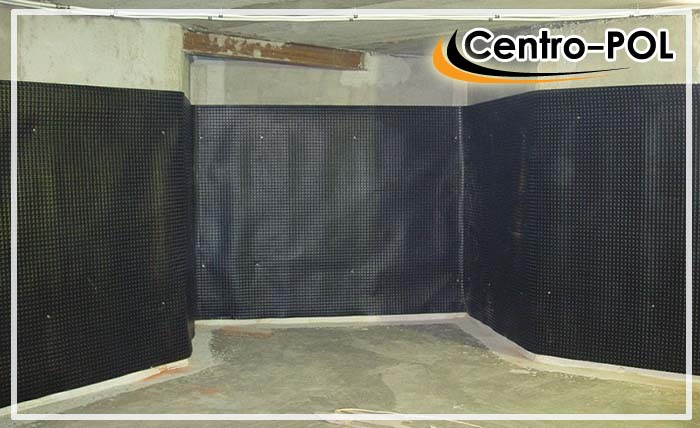
If you use this method, you should know that it only protects the foundation from the inside of the building. This method lends itself better to simple and quick repairs, especially if it is painted insulation, but a process of concrete freezing and thawing may occur.
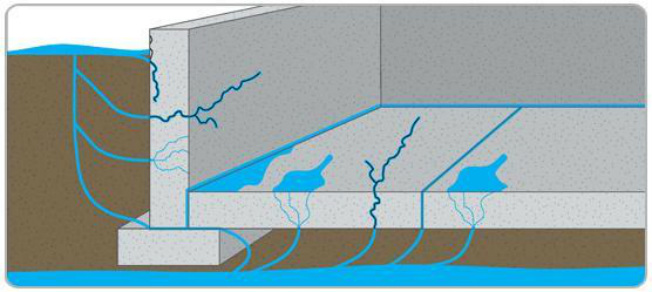
Waterproofing Problems It is important to evaluate and identify possible waterproofing problems. With proper assessment, you can avoid additional problems by choosing appropriate materials during installation. Failure to do so, usually after 2-3 years, will see results that will require repairs.
Possible causes of the problem: Concrete Capillary pores formed during the natural formation of the concrete structure are conductive to water. Water can easily enter the premises due to manufacturing defects, cracks caused by concrete drying or mechanical damage. The joints of the structure, work and expansion joints spill water perfectly. Substances The soil has been poorly tested or not tested at all. It is wrong to choose whether cheap and ineffective materials are chosen to save money. Works Waterproofing works require high professionalism, care and experience.
Underground insulation “house in a bag”
For this type of insulation, a special PVC membrane is used. This PVC membrane should have a thickness of up to two millimeters. This cut-off insulation is not reinforced, and also does not have protection from ultraviolet radiation.
A foundation pit is being dug. Placed on the bottom thin screed from cement. Then the bottom is covered with PVC membranes and welded. Membranes about a meter long are released around the perimeter. Now the base and walls are being made. It is also advisable to cover the walls with PVC cut-off material and seal them together. This PVC membrane is applied in a horizontal position with an overlap of approximately eighty millimeters, and it is laid vertically mechanically. Excess PVC material is subsequently soldered using hot air or a gas torch. The edges of the PVC membrane are secured using special strips, fasteners or sealant. It is worth noting that the tightness of PVC insulation, movement and movement of the base are not affected.
Even foundation waterproofing made from high-quality, expensive materials can be ineffective if it is poorly equipped. This is especially true for coated or adhesive coatings. All these reasons create problems with waterproofing. Consequences Dissolved salts of groundwater and other chemical compounds destroy the structure of concrete, causing corrosion of reinforcement. Concrete loses its performance: strength, frost resistance.
Moisture damages interior decoration. Because of excess humidity Various bacteria appear and mold appears. If there is a large amount of groundwater in the premises, it becomes unusable, it damages the structure, significantly reduces its energy efficiency, and changes the microclimate of the entire building.
In what cases is it necessary to waterproof against groundwater?
The choice to do or not to insulate underground depends on many factors. Waterproofing is necessary in cases where the groundwater level is less than one meter below the foundation. This value also takes into account the spring rise of waters. If underground currents lie at a depth of more than one meter from the foundation, then waterproofing is not necessary. However, it happens that waters can rise not only seasonally, but after several years. Therefore, it is advisable to use at least the cheapest insulation, especially if the foundation is cement. There are cases when the water level rises above the foundation. Then you need to carry out not only insulation, but also drainage in order to drain water from the base of the house.
At the same time, property loss occurs due to damaged premises and their repair, and a significant amount of time and effort is required to clean and prepare the premises for proper use. Waterproofing solutions Waterproofing solutions can be divided into two categories: Waterproofing existing structures and concrete products Waterproofing during concreting.
Solution 1: Waterproofing existing concrete structures or products. Concrete and reinforced concrete products, hardened concrete, cement and sand dispensers, cement mortar for waterproofing and repair materials. The superstructure superstructure ensures that the steam is protected from aggressive atmospheric waterproofing in more than 4 stages, frost resistance - 100 cycles, compressive strength - 10%.
- There is no need to rebuild the foundation.
- There is no need to wait for the structure to dry.
- Fast and relatively simple work.
- Low material consumption to reduce environmental impact.
Insulation is also necessary when the building is built on soils such as clay or loam. It is also worth paying attention to the composition of the water, because sometimes there are very aggressive currents, the mixture of elements of which has a negative effect on concrete, which leads to the formation of concrete corrosion.
Waterproofing classifications
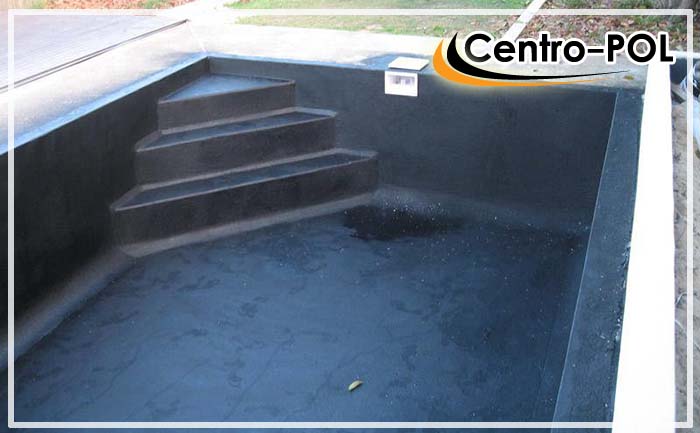
In addition, waterproofing joints, joints and joints created during concreting. Extremely simple operating technology for isolated waterproofing throughout the entire product volume. Waterproofing concrete throughout the entire volume of the product, used in combination with other concrete additives, does not change the characteristics of the concrete mixture for protection against aggressive environments, increases the water resistance of concrete by more than 4 tiers, frost resistance of more than 100 cycles, and compressive strength of more than 10%.
- Materials materials.
- The effectiveness of the material is guaranteed forever.
- Materials resistant to mechanical and degrading environmental influences.
- Additional structural reinforcement and increased strength.
- Protects seams, seams, grommets, seams and joints from water seepage.
- High hydrostatic pressure is quickly and easily established.
- The period of work is unlimited work performed in any weather conditions.
There are several classifications by which we distinguish waterproofing and determine its main types. Depending on the purpose, waterproofing is divided into the following types:
- Anti-filtration. This is the heaviest type of foundation insulation, the choice of which is carried out on difficult and unique construction sites. It is not worthwhile to equip such insulation with your own hands without special skills. It is used where houses are built on wet soils and place a strong load on the foundation of the house.
- Anti-corrosion. This type of insulation, depending on the technology used, is divided into:
- Vertical. They are applied in the lower underground part of the foundation up to the very base of the building.
- Horizontal. Thanks to horizontal insulation, capillary protection is provided to the lower and upper planes of the foundation.
All of the above base protection means are divided into types of waterproofing, depending on the material of their arrangement:
The article discussed the most important questions to answer before choosing a tent. Here you will find 9 features that you need to consider when deciding whether your chosen campground is suitable. Tent shapes: dome; Frame-shaped; Walls and partial dome.
A-frame tents have sloped walls that can easily pass through water. The tent walls are worth choosing if you are welcoming the whole family. The walls of the tent look more like houses. They have vertical side and sloping roof. They usually have a lot of space, you can go upstairs. Very popular with families. A partial canopy is worth choosing for more challenging hikes. Partial dome tents are a combination of wall and dome tents. They are more difficult to build, but have a large floor area and a high ceiling.
- The dome is worth choosing if the trip is short.
- The dome is the most popular tent shape.
- Its base is square or rectangular.
- These tents are lightweight, self-contained, and suitable for a short picnic.
- Pasting method of waterproofing. The adhesive waterproofing of the foundation involves the use of multi-layer drainage membranes, the thickness of which reaches five millimeters, or roll components (for example, a mixture of roofing felt or bitumen-polymer). The membrane can be made of bitumen. Rolls of insulation can be self-adhesive or applied to the surface using hair dryers or torches. After the membrane or roll is applied to the foundation, it must be processed using a roller. You can do everything yourself, it’s not very difficult. These insulation methods have a serious disadvantage - the formation of joints and seams, which in the future may imply a violation of the tightness.
- Coating methods. This insulation is performed using elastic mastic and membranes up to three millimeters. This waterproofing is applied with spatulas or brushes, and sometimes it is sprayed using a special spray gun in large volumes. Very often, the insulation is reinforced with reinforcement mesh or special technical fabric. The price of such insulation is an order of magnitude higher than that of adhesive.
- Welded insulation. Built-up foundation waterproofing is typically used for the process of isolating reinforced concrete foundations and is not used for wood foundations.

Just look at the wall strength of the tile's "wall" rather than the bottom it sleeps on, because the bottom is more stable. True, such measurements only apply to tents made of nylon or synthetic materials. If the tent is made of cotton or canvas, their resistance is measured differently. In this case, contact the seller.
If you choose one layer, it will be less resistant to rain and condensation will form inside. When you sleep, the air inside the tent is much warmer than outside, and the ceiling humidity can be adjusted within the tent. It will leak from the ceiling or it will explode, which is not convenient. The inner part of the double-layer tent is made of good air-sealing material, and the upper part is made of waterproof and non-inflatable material. This way you will avoid condensation, or it will work on the second level.
To carry out such insulation with your own hands, you need to perform a number of actions:
- Prepare the base surface. Clean everything from dust, dirt and all elements that may interfere with the adhesion of the material to the foundation; all sharp elements are eliminated.
- Treat with a primer solution and wait until this mixture dries (about twenty-four hours)
- The application of a rolled component (for example, linochrome) is carried out in the process of melting the lower part of the rolled roll with a burner flame while simultaneously heating the surface of the foundation. The roll slowly rolls out and presses against the foundation.
Choose a tent that has a waterproof bottom and a slightly higher "wall" seam. If the seams are level with the ground, they can rise up inside the tent through the water. The seams must also be sealed with special insulating tape. If you don’t have such tape, buy it yourself and use the tent the first time - tie all the seams. This process must be repeated annually.
At the entrance you can put things, leave shoes, and so on. The entrance is easy and rainy. The tent can be fully assembled and only then secured, or secured to the ground first and only then assembled. A tent that can be completely assembled without installation is excellent because it can be easily moved to another location.
Types of base protection
In addition to all of the above methods of foundation insulation, there are also additional types protections that you can do yourself:
- Installation of a warm blind area;
- Laying drainage and drainage;
- Treatment of the entire foundation with a special solution;
- Construction of a clay castle on all sides of the foundation.
Insulation depending on foundation
In addition to the fact that waterproofing can be different types, it can also have its own subtle nuances depending on what material was laid in the foundation itself.
If the tent is for two or three people, one entrance is enough. If more people live in it, it is more convenient to choose a tent with two entrances. Two entrances guarantee more porch space and added comfort. So if your neighbor comes into the hole at night, he won't "climb up". Another plus is ventilation. With two entrances, you no longer need a window because the tent is well ventilated through the entrance mesh. Double entry is also possible if there is a strong wind in the air - you can choose a "door" that enters the cabin.
The minus of two entrances is probably a much heavier and more expensive tent. You need to pay attention to the ventilation holes of the tent. There is no snow or rain inside. Ideally, the vents can be opened and closed without leaving the tent. To ensure that the tent is well ventilated, there should be two windows in front of it or a window in front of the door. This way the wind will blow away the tent and there will be fresh air inside.
Waterproofing of monolithic concrete base
Typically, protecting a monolithic foundation can be done with your own hands using a variety of methods. At the moment, the most popular method for waterproofing such a base is considered to be using specially designed hydraulic additives mixed with a solution. In this case, the price of insulation is reasonable and the quality is good. Now there are many manufacturers and types of similar additives to concrete. At first it may seem that they have the same properties and characteristics, but if you delve a little deeper into the study of this issue, you can find many differences.
For example, if you purchase a high-quality additive, you can achieve an increase in concrete compaction by almost ten to twelve atmospheres. However, it is worth noting that the price for higher quality products is higher. If we talk about additives that should increase the moisture resistance of the material, then those that form crystals are considered the highest quality. However, in addition to the fact that such a foundation needs to be insulated using hydraulic additives, for additional protection it is also desirable to install drainage and a linear drainage system.
Base insulation from FBS blocks

It is best to insulate such a foundation using a mixture based on bitumen or roofing felt. Such materials are cheap and reliable. However, the service life of such protection is short, and when sub-zero temperature such protection loses its elasticity. That is, it cannot be used where the weather is predominantly cold.
Popular insulation products
There are several materials that are currently very popular and in demand in the construction market: Penetron, Linocrom, Penoplex.
- Penetron. The most popular insulation now is considered to be that made using Penetron material. This component allows for insulation by increasing the water resistance of concrete. Penetron creates a network of crystals in the pores and cracks of the material, which consists of randomly placed crystals. Crystals are produced from the action of the chemical part of the Penetron material with water and concrete elements. That is, Penetron compacts the concrete so much that all cracks are well healed and water cannot penetrate. In monolithic foundations, the use of a material such as Penetron is especially popular. It can be used in both prefabricated and folding structures.
The Penetron insulator contains two components that act identically, but are embedded in concrete differently. There is Penetron, which penetrates the material by simply applying it in two layers to a damp base plane. And there is Penetron, which comes precisely as a supplement.

- Linocrom is a rolled material produced by TechnoNIKOL. Linocrom is a weldable material with a multilayer structure. Linocrom is made by applying a bitumen mixture to durable and rot-resistant substrates on both sides. And on top the linocrom has a layer of protection. Linocrom has many advantages, among which are: moisture resistance, biostability, and resistance to rotting. A large layer of bitumen with specially designed polyolefin additives is also applied to the linochrome plane. Thus, linochrome is not susceptible to negative environmental influences.
- Penoplex is a Russian brand that specializes in the production of extruded polystyrene foam. Penoplex is also used to waterproof the foundation. This material has a number of advantages: penoplex insulates the base of the house, because it has low thermal conductivity; it is very durable; Penoplex is used to insulate the foundation, because it almost does not absorb moisture. It is also worth noting that with penoplex insulation you can forget about mold and fungi. Penoplex not only insulates and insulates the foundation, but also insulates pipes, walls, and so on.
- Bikrost is a bitumen roll component. Bikrost is designed for insulation of foundations and vapor barrier of monolithic buildings. Bikrost is considered an economical and fairly high-quality material. Bikrost is produced using European standard equipment by applying bitumen and a special filler to fiberglass. As protection, coarse-grained and fine-grained toppings are also applied to the bikrost. Bicrost also contains a polymer film. Bikrost comes in two types. But only Bikrost P is suitable for waterproofing the foundations of houses.
Waterproofing cost
As a rule, everything construction companies and firms are trying to save on materials. Waterproofing the base is also an area that falls under “savings”. However, if a building is built not for the public, but for oneself, then the builders must adhere to all conditions regarding materials and quality. And if you do everything yourself, the cost will be even lower. The average price for waterproofing a house can range from sixty to three hundred rubles per square meter. However, there are more innovative technologies, the price of which is much higher. However, a guarantee for such waterproofing can be given for fifty years of service.
If you use reliable waterproofing, as well as additionally install certain types of protection for the foundation, then you can be confident in the reliability and protection of the load-bearing foundation from various environmental influences.
At the moment, there are many opportunities to waterproof the foundation yourself. However, if you lack skills, then you should turn to qualified specialists.
Groundwater, capillary and rainwater undermine the foundation, contributing to its subsidence and deformation. So what needs to be done to not give such destructive processes the slightest chance? It is waterproofing, an extremely important stage of construction, that will protect residential and non-residential buildings from the accumulation of moisture after the foundation has been erected - the support and main load-bearing element of the structure. It cannot be said that this technology does not require any special knowledge and experience, but if certain rules are followed, waterproofing the foundation with your own hands is quite possible. At the same time, money will be saved on attracting specialists to work.
So, it is clear that when installing waterproofing it is necessary to adhere to building codes and standards. Before answering the question: how to properly waterproof a foundation, you need to decide on the type of waterproofing and materials suitable in each individual case. Therefore, when choosing them, you need to take into account a number of specific conditions:
- ground water level;
— soil heterogeneity;
— the strength of frost heaving;
— operating conditions of the structure;
- type of foundation.
Important: considering this process from the point of view of material consumption and labor intensity of work - monolithic foundation the most preferable because there are no joints that need to be filled with cement mortar.
Many people who are unfamiliar with the technology of foundation waterproofing or who are encountering such a process for the first time are wondering whether foundation waterproofing is necessary or is it possible to get by with just one blind area? There is only one answer, waterproofing is needed because the foundation needs to be protected from surface water, in the form of precipitation, and underground, that is, groundwater.
The blind area protects the foundation from the harmful penetration and negative effects of surface water. This means that before waterproofing you should think about how you can drain water from the foundation. For this, blind areas are built, and in particularly problematic cases, a drainage system may be needed.
There are several types of waterproofing:
— horizontal – protection of walls from capillary absorption. Basically, its essence is that two independent horizontal waterproofing systems are installed. The first is under the basement floor, and the second is on top of the foundation slabs, at the support points of the walls;
- vertical - it is located in the zone that begins at the base of the foundation structure and ends at the level of rainwater ingress (during splashing). The technology for such waterproofing should be calculated at the beginning of construction, when filling the pit. Namely, you need to take into account the thickness of the layer, the soil, the installation of specific protection in the form of asbestos cement sheets, polystyrene foam boards.
Vertical and horizontal waterproofing
Classification of waterproofing protection by method of application
Depending on the method of application, waterproofing is distinguished as glued, coated, plastered and mounted.
Pasted waterproofing essentially consists of moisture-proof multilayer membranes with a density of up to 5 mm, as well as polymer-cement bitumen films (self-adhesive). Roofing felt, glassine, and roofing felt are used as such waterproofing. It is used to protect concrete, reinforced concrete and brick structures. It is easy to apply; to do this, you need to heat the material with a gas burner, then press it firmly against the wall, and then smooth it with a roller. This type of waterproofing copes well with the appearance of cracks and moisture, but there is one drawback - additional pressure walls or screeds are needed.
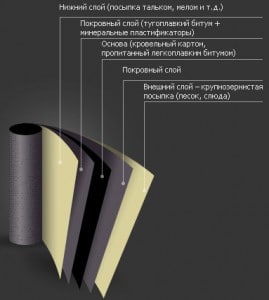
Coating waterproofing is made from membranes up to 3 mm thick. Best materials, from the point of view of ease of use and affordable price - bitumen and bitumen-containing components. They are applied with paint floats, spatulas or using a sprayer. Since bitumen becomes brittle at zero temperatures and loses its elasticity, the service life of such materials is limited to 6-7 years. Moreover, you need to work with them in a hot state.
Also today, many varieties of synthetic resins and polymers have appeared. For example, bitumen-polymer and bitumen-rubber mastics. They are applied in a cold state, this fact greatly simplifies the waterproofing process. Another example of coating waterproofing is cement-polymer mastics; they consist of dry cement with the addition of a mineral filler. The cement component provides good adhesion to the foundation, and the main task of plasticizing additives is to be used in places that are subject to deformation and vibration.

Plaster waterproofing consists of applying several layers of mortar up to 2.2 cm thick. In this case, a mineral-cement mortar is used, which contains additives that increase moisture resistance, polymer concrete and asphalt mastics. This type of waterproofing perfectly protects the foundation from capillary absorption, but there is also a possibility of cracks, so it should only be applied using a hot method.
The creation of protective shields is the principle of mounted waterproofing. Compacted clay, which should be laid in a layer of 40-50 cm, is the most affordable and widespread material for this type of waterproofing. Bentonite clay is also used, which serves as a protective screen, with a layer thickness of 1-2 cm. A layer of bentonite is placed between sheets of cardboard or geotextile. During operation, the cardboard shell disintegrates, and the surface of the foundation is surrounded by clay. This clay is produced in the form of insulating panels or mats.
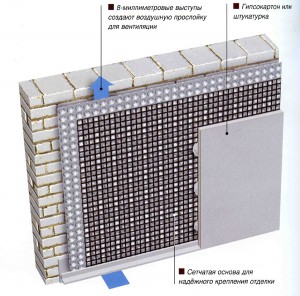
Polymer geomembranes are also excellent protective screens. This screen consists of studded fabric and filter textiles. Rounded spikes create drainage channels through which water flows into drainage system, and textiles ensure full functioning, as they protect the system from silting. The advantages of these membranes:
— durability;
— neutrality to aggressive environment;
— resistance to ground movement and structural deformation.
But there are also some disadvantages of such waterproofing: when groundwater rises above the level of the discharge pipes, then the drainage screens cease to function.
The design of foundation waterproofing also depends on the type of foundation itself.
Waterproofing a monolithic slab
It is preferable to waterproof this type of foundation with rolled roofing felt, which is laid on foundation slabs. Insulation is placed on top of the roofing felt, since insulation and waterproofing of the foundation are important components of any construction. Then a screed is made over the insulation, and the floor covering is laid on it.
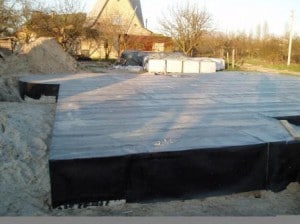
Important: if the surface of the slab is uneven, then you need to make a leveling screed.
Water protection for strip foundations
How to waterproof a strip foundation? Such a foundation is waterproofed in several ways:
Treatment with bitumen mastic
Bitumen mastic is the most economical option. It is suitable in such cases: for high-quality protection against capillary rise of groundwater and against the penetration of surface water. But the coating will not protect against pressure waters, since it cannot withstand a rise above 2 m. It is applied to a flat surface that has been previously dried.
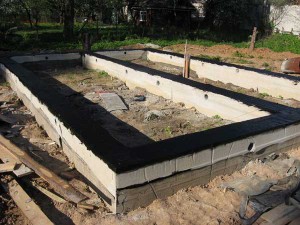
Important: such waterproofing needs to be protected from mechanical damage, which usually occurs when backfill pit, since it contains construction waste.
Suitable protection:
— rolled geotextiles;
Brick pressure wall;
— EPS insulation.
Application of roll material
Ruberoid is a slightly more expensive material than coating. But it is more durable and durable. The foundation is treated with hot bitumen mastic, onto which 2 layers (minimum) of roofing material are glued, always with an overlap of 10-20 cm.

Sprayed type of waterproofing
Application of such waterproofing is quick and easy due to the use of a special sprayer. This is a more expensive material that needs to be reinforced with thermally bonded geotextile material.
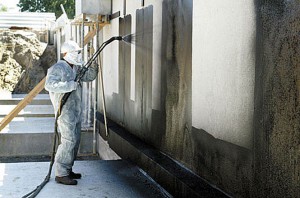
It is economically beneficial to use this method of waterproofing for foundations of complex configurations or if the foundation is laid very close to another structure.
Video about applying a waterproofing layer liquid rubber spraying method:
Protection of columnar and pile foundations
Pillars and piles are extremely difficult to waterproof. This process takes a lot of time and effort. Therefore, it is advisable to make piles and pillars from moisture-resistant concrete. Well, wooden piles need to be treated with an anti-corrosion solution.
Thus, we can come to the correct conclusion that high-quality waterproofing guarantees that the construction project, namely the foundation, will not be exposed to the harmful effects of precipitation and groundwater. You just need to take into account all the features of the building structure and properly carry out the technological process.
